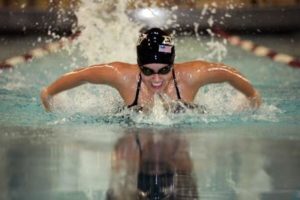- Calls to this hotline are currently being directed to Within Health or Eating Disorder Solutions
- Representatives are standing by 24/7 to help answer your questions
- All calls are confidential and HIPAA compliant
- There is no obligation or cost to call
- Eating Disorder Hope does not receive any commissions or fees dependent upon which provider you select
- Additional treatment providers are located on our directory or samhsa.gov
Inside the Summer Olympics: Competitive Swimming & Eating Disorders

Contributor: Courtney Howard, B.A., Executive Assistant at Eating Disorder Hope and Addiction Hope
The 2016 Summer Olympics commence in Rio later this week. Though not usually a popular spectator sport, competitive swimming is really thrust into the spotlight as a crowd favorite during the Olympics every four years.
Swimmers, both male and female, face a unique set of pressures when it comes to weight and body image. We want to take this time during the Olympics to address these issues and support swimmers from all over the world who might be struggling with disordered eating.
“Weight Pressures” in Swimming
The eating disorder community often acknowledges eating disorders among athletes, and some centers even have specialized programs aimed at treating athletes. Gymnastics and figure skating, being highly aesthetic sports, are often given the most attention. Similar issues facing competitive swimmers are less defined and often go unrecognized.
A 2001 survey [1] using the Weight Pressures in Swimming (WPS) inventory found that more than half of female collegiate swimmers agreed with the statement, “There are weight pressures in swimming.” These weight pressures range from revealing swimsuits and scrutiny from crowds to the widely held perception that weight loss improves swim times.
One factor with competitive swimsuits is not just that they are revealing compared to uniforms for other sports, but that swimmers are often encouraged to wear smaller sizes than naturally fit their bodies. This is believed to reduce drag or friction, improving speed in the water. Naturally, wearing an extremely tight swimsuit that is multiple sizes too small while training every single day can lead to distorted body image.
Personality Factors in Swimming & Disordered Eating

There is always a chance to improve your times, even by a millisecond, and perfect your performance. Though often an admirable quality in athletes, this constant pursuit of self-improvement and perfection can bleed into other realms of a swimmer’s life, including eating patterns and weight management.
Being a people-pleaser often coincides with this perfectionism both in and out of the pool, whether it be perceived pressure to please coaches, teammates, fans, or loved ones. This is often magnified for Olympic athletes. The obsessive nature that drives them to excel in their chosen sport can be harnessed in a negative way for those prone to disordered eating. Both people-pleasing tendencies and perfectionism are common among those with eating disorders.
Elite Swimmers and Their Stories

Having hit the Olympic swimming scene at such a young age, Beard faced immense scrutiny when she grew in both height and weight between the ages of 14 and 15. Of course, she was a young woman going through puberty so these increasing measurements were natural and healthy, but her swim times were negatively affected as she got used to swimming in her more mature body. Being in the public eye did not help. At the time, she was also coping with her parents’ divorce.
Beard developed bulimia nervosa, which worsened when she went to college. Instead of improving her swimming as she had hoped, her eating disorder made her weak and hurt her swim performance. As she stated in a 2009 speech to the student body at Cal Poly San Luis Obispo, “My swimming was struggling. At that time, I didn’t care as much about my swimming as I did about being thin. That just shows how sick I was.”
Throughout the end of her swimming career, Beard was offered high-profile modeling gigs, which served as another trigger for her eating disorder. Now recovered, Beard also has a history depression and self-harm, as chronicled in the aptly titled, “In the Water They Can’t See You Cry: A Memoir.”

Knutson used food to cope with the intense life transitions she faced when finishing high school, briefly swimming for Auburn University, then quickly going pro. Her eating disorder left her weak and often bloated while trying to train, which adversely affected her swimming. This led to more self-criticism, which Knutson explains led to pushing herself and her body in ways that were almost compulsive.
Hitting rock bottom prior to the 2012 Olympic trials, Knutson realized she needed help for her bulimia nervosa. She has officially retired from swimming and is doing well in her recovery.
Recovery is Possible
If you are a competitive swimmer or involved in any sport, disordered eating and body image issues might seem difficult to escape. The reality is that full recovery from an eating disorder is possible. Reach out for help today.
Community Discussion – Share your thoughts here!
What other factors might influence disordered eating among competitive swimmers?

References:
[1]: Reel, J.J. & Gill, D.L. (2001). Slim enough to swim? Weight pressures for competitive swimmers and coaching implications. The Sport Journal, Vol. 4, No. 2, Spring 2001.The opinions and views of our guest contributors are shared to provide a broad perspective of eating disorders. These are not necessarily the views of Eating Disorder Hope, but an effort to offer discussion of various issues by different concerned individuals.
We at Eating Disorder Hope understand that eating disorders result from a combination of environmental and genetic factors. If you or a loved one are suffering from an eating disorder, please know that there is hope for you, and seek immediate professional help.
Last Updated & Reviewed By: Jacquelyn Ekern, MS, LPC on August 1, 2016
Published on EatingDisorderHope.com
